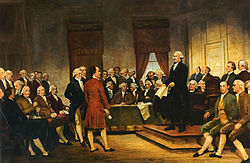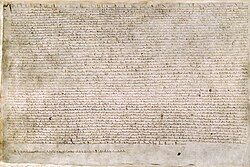Constitution
The constitution of a country (or a state) is a special type of law document that tells how its government is supposed to work. It tells how the country's leaders are to be chosen and how long they get to stay in office, how new laws are made and old laws are to be changed or removed based on law, what kind of people are allowed to vote and what other rights they are guaranteed, and how the constitution can be changed.
Limits are put on the Government in how much power they have within the Constitution (see Rule of Law ). On the other hand, countries with repressive or corrupt governments frequently do not stick to their constitutions, or have bad constitutions without giving freedom to citizens and others. This can be known as dictatorship or simply "bending the rules". A Constitution is often a way of uniting within a Federation.
The UK's constitution is not written in one single document like many other countries' are. In fact, the UK's constitution is not completely written down at all. Some of it can be found in writing, starting with Magna Carta of 1215 and the Bill of Rights Act 1689 and including more modern Acts of Parliament. Other parts of it are considered common law and are made up of the decisions of judges over many hundreds of years in a system called legal or judicial precedence. Because of this, some people say that the United Kingdom has a de facto or "unwritten" constitution.[1]
The United States in 1787 began a trend in the writing of constitutions. The United States Constitution is also the shortest that people are still using, and it has been changed (amended) many times over the years. It was made after the colonists won their independence from Britain. At first they had the Articles of Confederation but the Articles were replaced with today's Constitution.
The Indian constitution of 1950 is the longest ever written constitution in the world. It originally consisted of 395 Articles arranged under 22 Parts and 8 Schedules. As of 2021, it has 470 Articles, 12 schedules, and 25 Parts with 5 appendices and 98 amendments.
Constitution Media
Constitution of the Kingdom of the Two Sicilies in 1848
Diagram illustrating the classification of constitutions by Aristotle
The Cossack Constitution of Pylyp Orlyk, 1710
A painting depicting George Washington at the Constitutional Convention of 1787 signing of the U.S. Constitution
Presidential copy of the Russian Constitution
The Magna Carta (originally known as the Charter of Liberties) of 1215, written in iron gall ink on parchment in medieval Latin, using standard abbreviations of the period, authenticated with the Great Seal of King John. The original wax seal was lost over the centuries. This document is held at the British Library
Related pages
References
- ↑ Barnett, H. (2005). Constitutional and Administrative Law (5 ed.). London: Cavendish. p. 9.
Conversely, "A written constitution is one contained within a single document or a [finite] series of documents, with or without amendments", id.








